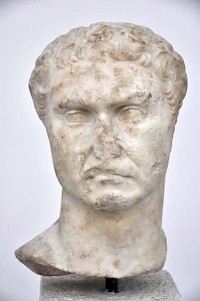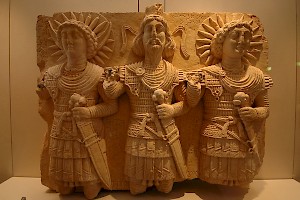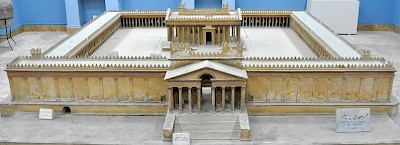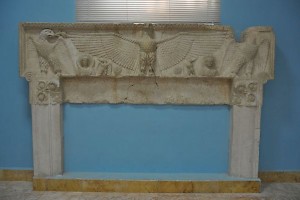Palmyra (2)
Q5747Palmyra or Tadmor: oasis in the desert between Damascus and the Euphrates, important trade center, and capital of a semi-indepent state in the third century CE.
The First Century

In the first part of this article, we saw that Tadmor/Palmyra was an important oasis between the Euphrates in the east and Damascus and Emesa in the west. When the disintegration of the Seleucid Empire started, after about 145 BCE, the trade route through the desert became increasingly important and in 41, the town was sufficiently prosperous to attract Roman attention. Appian of Alexandria writes:
[Mark] Antony sent a cavalry force to Palmyra, situated not far from the Euphrates, to plunder it, bringing the trifling accusation against its inhabitants, that being on the frontier between the Romans and the Parthians, they had avoided taking sides between them; for, being merchants, they bring the products of India and Arabia from Persia and dispose of them in the Roman territory; but in fact, Antony's intention was to enrich his horsemen. However, the Palmyrenes were forewarned and they transported their property across the river, and, stationing themselves on the bank, prepared to shoot anybody who should attack them, for they are expert bowmen. The cavalry found nothing in the city. They turned round and came back, having met no foe, and empty-handed.note
This is the first recorded use of “Palmyra”, the Roman name of Tadmor. There is of course a reference to the Latin palma, “palm tree”, although it appears to be a phonetic rendering of the Aramaic original as well, dhmr/Tadmor.

After this, Roman interest continued to grow. A milestone, found in Khirbat al-Bil’as, records how Q. Caecilius Metellus Creticus Silanus, the governor of Syria between 13 and 17, drew the boundaries between his province and Palmyra. Statues of the emperor Tiberius, Germanicus, and Drusus the Younger were erected in the temple of Ba’al.note

The Palmyra Tax Tariff, an inscription from 137, contains references to several Roman officials who had intervened in the Palmyrene economy, including Germanicus and Corbulo, who had written to Roman officials who had to adjudicate disputes.note It is likely that there was some kind of Roman garrison as well. We also hear about a Palmyrene unit in the Roman army, the Ala Ulpia I Dromedariorum Palmyrenorum, the First Ulpian Squadron of Palmyrene Dromedary Riders.

Meanwhile, Palmyra flourished. It appears to have been one of the places where merchants, arriving from the Parthian Empire, were allowed to enter the Roman Empire. There were trade contacts with the Persian Gulf, and the find of silk proves that there were indirect contacts with China as well. The tax tariff shows how the Roman government benefited from the international trade, but Palmyra itself benefited too. We know that some of the profits were spent on construction work at the temple of Ba’al, which was inaugurated in 32, on the sixth of Nisan. The date is significant, because it means that the Palmyrenes celebrated the Babylonian Akitu festival.

The gods that were venerated in this fashion, were Yarhibol (the Sun), Aglibol (the Moon), and a female deity, who may have been the love goddess Astarte or the war goddess Allat. So, we find Syrian deities, a Babylonian festival, people with Arabic names, and a sanctuary that looks like a Greek or Roman temple. It's quite a mix, but the Palmyrenes adapted whatever they borrowed to their own needs. Yes, that temple resembled a Greek or Roman sanctuary, but the offering of the sacrifices on a platform on the roof, would be unthinkable in Greece or Rome itself.

In the last quarter of the first century, many monuments were built. The temple of Ba'al was surrounded by a large portico, eleven meters high and measuring 205 x 210 meters. At some distance, the temple of the Babylonian wisdom god Nabu was constructed, which was probably used as an oracle. To the north, we find a new temple, dedicated to the Phoenician god Ba'al Šamem, where this "lord of heavens" was venerated together with Yarhibol and Aglibol.
In 106, the emperor Trajan added the Nabataean kingdom to the Roman Empire. It looks as if the Nabataean trade network was dismantled and Palmyra benefited. The second century was to witness the construction of several splendid monuments.